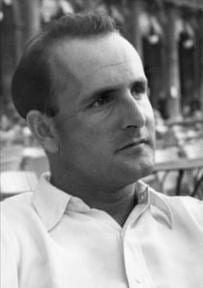 |
| Photo of Walter Kempner. Source. |
Walter Kempner, the doctor with the thick German accent who came to America to escape from the Nazis, was born in 1903. Son of two bacteriologists who had both worked on tuberculosis, he graduated in medicine from the University of Heidelberg in 1928 and subsequently worked there and in Berlin. When the anti-Jewish laws were introduced in Germany in 1933, he was dismissed from his clinical position. The following year he emigrated to America and joined the faculty of medicine at Duke University, Durham, North Carolina, where he introduced his famous rice diet, low in salt and protein.
There was no effective treatment for hypertension at the time, as shown by the history of President Franklin Roosevelt. Low-salt diets had been tried by L. Ambard and E.B. Beaujard in France in 1904 and by F. M. Allan and J.W. Sherrill in America in 1922. Kempner introduced an even more restrictive diet because he believed that hypertension was a more complex metabolic dysfunction than merely a state requiring salt restriction. He limited protein intake to 20g per day, restricted fluid intake, and prescribed a diet containing only rice, fruit, and sugar. It provided 2,000 calories with added vitamin supplements and sometimes citrate-containing fruit juices to counteract metabolic acidosis. Sodium intake was 150mg per day. Occasionally and reluctantly the addition of bread, fish, lean meat, and other treats was permitted.
Results were reported as though all hypertensives had the same etiology. Of the original cohort of 192 people, 25 patients died, 60 patients had no substantial improvement, but in 107 patients the blood pressure fell significantly, from 200/112 to 149/96 mmHg. Heart size decreased in 66 of 72 patients, edema often disappeared, and various publications dramatically illustrated the occasional disappearance of papilledema and the remarkable weight loss in some massively obese individuals.
 |
| Photo by Mgg Vitchakorn on Unsplash |
Dr. Kempner had a domineering personality, and not all staff physicians and colleagues remember him with favor. He bullied his patients into compliance, yelled at them when he caught them straying from his diet, and watched them like a hawk, involving himself in their daily lives, even buying private homes which he converted into “rice houses” where his patients would live with a rice chef and be closely monitored.
Soon other physicians began to use his rice diet. Among them was the author of the popular 1954 textbook Hypertension and Nephritis, Arthur M. Fishberg. Based on his experience in New York with his own patients and with those of others, he confirmed that heart failure and headaches often improved. Most patients found the diet repugnant and eventually refused to stay on it. The clinical response was the same as that of a simple 200mg sodium diet. Limiting protein and water intake was unnecessary, the diet was too restrictive, and uremia could be precipitated in patients with renal insufficiency. In addition, “immoderate acclaim by the press” resulted in the widespread opinion that rice itself had an antihypertensive effect. As Chinese patients were believed not to suffer from hypertension, articles in the press showed smiling Chinese men enjoying a huge bowl of rice in addition to their ample normal diet. Clearly, however, eating only rice made sodium restriction easy to understand though not to follow.
Little regard was paid in those days to the difference between hypertensives with severe narrowing and constriction of the blood vessels and those with expanded intravascular volume. As shown in the decades to follow, the latter constitute the majority of hypertensive patients and would be greatly helped by salt restriction but are now treated with diuretics and effective drugs that were not available in the 1940s and 1950s. The Kempner diet, advocated over half a century ago, is now only of historic interest, a signpost in the long fight against a disease that even now we do not completely understand.
References
- Klemmer P, Grim CE. Luft AC. Who and what drove Walter Kempner: the rice diet revisited. American Heart Journal 2014, 64:684 (October)
- Fishberg AM, Hypertension and Nephritis. pp 860-867. Lea and Febiger. 1954.
- Pickering G. High Blood Pressure. pp 394- 395. Grune and Stratton Inc. New York 1968
GEORGE DUNEA, MD, Editor-in-Chief
Highlighted in Frontispiece Volume 13, Issue 2– Spring 2021
Fall 2020 | Sections | Nephrology & Hypertension

Leave a Reply